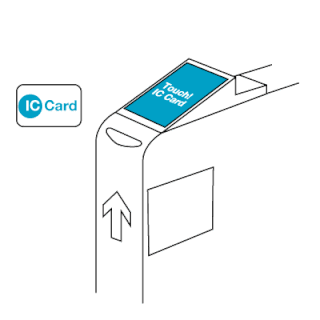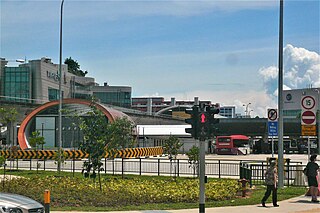
Transportation in Singapore is predominantly land-based, with a comprehensive network of roads making many parts of the city-state, including islands such as Sentosa and Jurong Island, accessible. The road network is complemented by a robust rail system consisting of the Mass Rapid Transit (MRT) and the Light Rail Transit (LRT), which cover the length and width of Singapore and serve a few neighbourhoods respectively. The main island of Singapore is also connected to other islands via ferryboat services. Furthermore, the city-state maintains strong international connections through two bridges linking it to Malaysia – the Causeway and the Second Link – and the Singapore Changi Airport, a major aviation hub in Asia.

The Mass Rapid Transit system, locally known by the initialism MRT, is a rapid transit system in Singapore and the island country's principal mode of railway transportation. The system commenced operations in November 1987 after two decades of planning with an initial 6 km (3.7 mi) stretch consisting of five stations. The network has since grown to span the length and breadth of the country's main island – with the exception of the forested core and the rural northwestern region – in accordance with Singapore's aim of developing a comprehensive rail network as the backbone of the country's public transportation system, averaging a daily ridership of 3.4 million in 2019.
SBS Transit Ltd is a multi-modal public transport operator in Singapore operating bus and rail services. With a majority of its shares owned by Singaporean multinational transport conglomerate ComfortDelGro Corporation at 75%, it was formerly known as Singapore Bus Services before rebranding to SBS Transit on 1 November 2001.

SMRT Corporation is a multi-modal public transport operator in Singapore operating bus and rail services. A subsidiary of the Government of Singapore's Temasek Holdings, it was established on 6 August 1987 and listed on the Singapore Exchange from 26 July 2000 until 31 October 2016. It is one of the two major operators of Singapore's rail services along with SBS Transit.

The EZ-Link card is a rechargeable contactless smart card and electronic money system that is primarily used as a payment method for public transport such as bus and rail lines in Singapore. A standard EZ-Link card is a credit-card-sized stored-value contact-less smart-card that comes in a variety of colours, as well as limited edition designs. It is sold by TransitLink Pte Ltd, a subsidiary of the Land Transport Authority (LTA), and can be used on travel modes across Singapore, including the Mass Rapid Transit (MRT), the Light Rail Transit (LRT), public buses which are operated by SBS Transit, SMRT Buses, Tower Transit Singapore and Go-Ahead Singapore, as well as the Sentosa Express.

Public buses form a significant part of public transport in Singapore, with over 3.6 million rides taken per day on average as of December 2021. There are 352 scheduled bus services, operated by SBS Transit, SMRT Buses, Tower Transit Singapore and Go-Ahead Singapore. The newest bus operator, Go-Ahead Singapore started operation on 4 September 2016. There are also around 5,800 buses currently in operation as of 2020.

The Light Rail Transit (LRT) is a series of localised automated guideway transit systems acting as feeder services to the heavy rail Mass Rapid Transit, which together forms the core of Singapore's rail transport services. The first LRT line was opened in 1999 and the system has since expanded to three lines, each serving a new town, namely Bukit Panjang LRT line, Sengkang LRT line and Punggol LRT line. Trains on these lines have at least one station interchange link to the MRT.

Woodlands Bus Interchange is a bus interchange in Singapore. Located in Woodlands, the interchange is linked to Woodlands MRT station and adjacent to Causeway Point shopping mall. It is the largest and among the busiest bus interchange in Singapore. The interchange is also known as Woodlands Integrated Transport Hub.
SMRT Buses is a second largest bus operator in Singapore. A subsidiary of SMRT Corporation, it traded as Trans Island Bus Services until 10 May 2004.

Sembawang MRT station is an elevated Mass Rapid Transit (MRT) station on the North–south line (NSL). Located in Sembawang, Singapore along Sembawang Road, the station is close to the Sun Plaza shopping centre and Sembawang Bus Interchange. The station is operated by SMRT Trains.

Kranji MRT station is an elevated Mass Rapid Transit (MRT) station on the North South line (NSL). Situated in Sungei Kadut, Singapore along Woodlands Road, it serves the Singapore Turf Club and the Woodlands Wafer Fabrication Park. The station is operated by SMRT Trains.
Vehicle registration plates in Singapore are administered by the Land Transport Authority. All vehicles in Singapore are required to display front and back plates bearing its registration number. Purchasers of vehicles have the option to bid for a vehicle registration number or get a vehicle registration number automatically assigned. Vehicle registration numbers can be retained on new or old vehicles owned by the same person. Vehicle owners are also able to replace and bid for a new registration number for existing vehicles.

Rail operators are government-assisted profit-based corporations, fares and ticketing on Singapore's Mass Rapid Transit (MRT) system are aimed to break-even or exceed operating expenses. Rail operators collect fares based on account-based (ABT) and card-based ticketing options, the prices of which are calculated based on the distances travelled between the origin and destination. These prices increase in stages for standard non-concessionary travel, according to the distances travelled. In account-based ticketing, the fare is automatically calculated in the back-end and charged to the passenger post journey. On the other hand, card-based ticketing is proprietary to the transport network and the fare is computed by the system based on the store values recorded in the cards. The public transit system is harmonising towards full ABT.

Tampines Bus Interchange is a bus station in Tampines, Singapore. It serves as the primary bus interchange for Tampines New Town, with feeder and trunk services operating at high frequencies. It is owned by the Land Transport Authority and operated by SBS Transit Ltd.

SMRT Trains Limited is a rail operator in Singapore and a wholly owned subsidiary of SMRT Corporation. After the privatisation of the MRT operations in 1995, it was originally named Singapore MRT Limited. On 31 December 2001, it was renamed to SMRT Trains Limited, so as not to confuse with another MRT line - North East MRT Line that is under Singapore Bus Services and the bus operations merged from Trans-Island Bus Services. At the same time, Singapore Bus Services was renamed to SBS Transit to be multi-modal. SMRT Trains currently manages most of the MRT services in Singapore except the North East Line and Downtown Line.

Yishun Bus Interchange is located in northern Singapore, integrated with the Northpoint City shopping mall. The interchange is part of the Yishun Integrated Transport Hub (ITH), which opened on 8 September 2019. Before this interchange, the original bus interchange was in operation from 23 August 1987 to 13 March 2015. Operations were transferred to a temporary site on 14 March 2015 for the construction of Yishun Integrated Transport Hub (ITH), and eventually closed on 7 September 2019.
Bulim Bus Depot is the first bus depot to be built by the Land Transport Authority in Singapore. It houses the buses of 30 bus services under the Bulim Bus Package. It is located along Bulim Avenue in Jurong West. Since 31 July 2015, the Bulim Bus Depot is being operated by Tower Transit Singapore. The depot was officially opened by Hong Kah MP Amy Khor on 6 December 2015.

Tower Transit Singapore is a contracted bus operator operating in Singapore. It commenced operations on 29 May 2016 and it is a subsidiary of Kelsian Group.

The Bus Contracting Model (BCM), formerly known as the Government Contracting Model, is a contracting model introduced by the Land Transport Authority (LTA) in 2014 for public buses in Singapore, implemented in 2016. The BCM is based on the Transperth model in Perth, Western Australia with quality incentive elements from London Buses. Under the BCM, local and overseas bus operators bid for contracts to operate public bus services on behalf of LTA. The LTA has also adopted a new unified lush green livery and logo for all buses, and now procures and owns the bus fleet for all public bus services in Singapore.

















